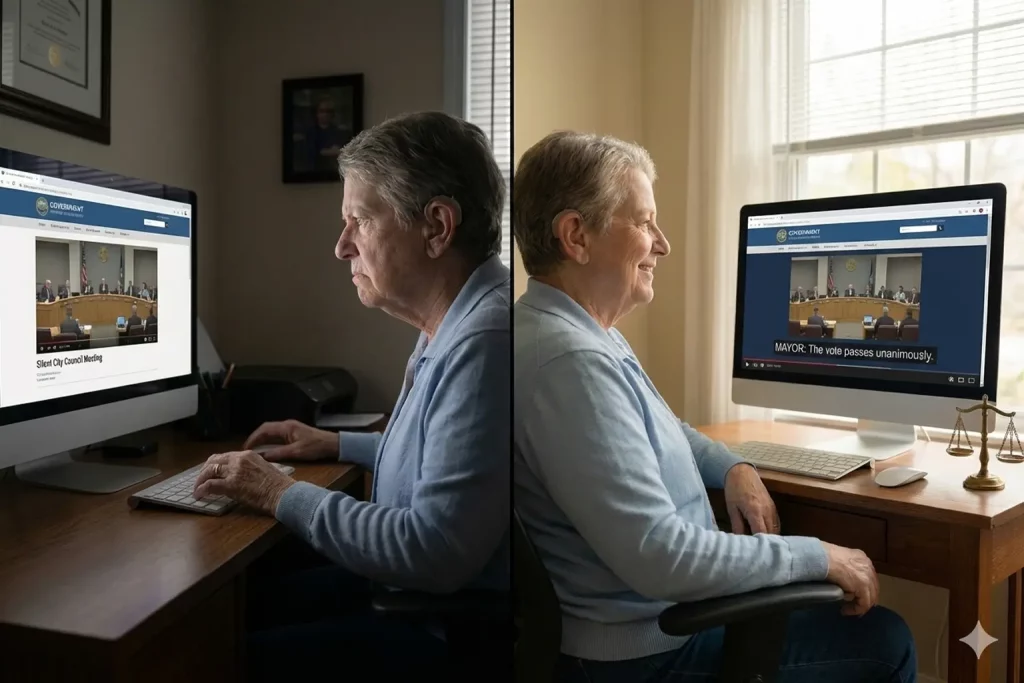In today’s media landscape, where viewers can access many platforms and content, delivering high-quality broadcasts is no longer a luxury but a necessity. Quality of Experience (QoE) Monitoring has emerged as a game-changer in the broadcast industry, playing a crucial role in enhancing viewer satisfaction and operational efficiency. This guide delves into the significance of QoE in modern broadcasting, exploring its multifaceted impact and providing practical steps for implementation.
What Does QoE Mean?
QoE Monitoring measures the perceived quality of a broadcast from the viewer’s perspective. Unlike Quality of Service (QoS), which focuses on network performance, QoE captures the end-user’s experience. This includes factors like video and audio quality and the seamlessness of content delivery. The significance of QoE in broadcasting lies in its direct correlation with viewer retention and satisfaction.
The Critical Role of QoE in Modern Broadcasting
As the digital world accelerates, broadcasters face immense pressure to deliver flawless viewing experiences. QoE Monitoring goes beyond simply ensuring uptime and bandwidth; it encompasses the overall satisfaction of the viewer. By monitoring factors like video resolution, audio clarity, and content relevance, broadcasters can proactively address issues before they detract from the viewing experience, leading to higher viewer engagement and satisfaction.
QoE and Its Impact on Viewer Satisfaction
Quality of Experience (QoE) goes beyond traditional metrics like uptime and bandwidth to encompass the viewer’s overall satisfaction. This includes variables such as video resolution, audio clarity, and even content relevance. By monitoring these elements, broadcasters can proactively address issues before they detract from the viewer’s experience, thus maintaining high levels of viewer engagement and satisfaction.
What Does QoS Mean?
While QoE is user-centric, Quality of Service (QoS) is a more technical measure that focuses on the performance properties of a network or service, such as bandwidth, latency, and packet loss. QoS metrics are generally easier to quantify and more objective, focusing on the technical delivery aspects.
In contrast, QoE offers a broader view, incorporating these technical metrics and blending them with user feedback and perceptions. While QoS is crucial for ensuring that services perform as expected, it doesn’t necessarily guarantee a high QoE if the end user’s expectations and experiences are unmet.
Differences Between Quality of Experience (QoE) and Quality of Service (QoS)
While QoE and QoS are often used interchangeably, they serve distinct purposes:
- QoE is user-centric: It prioritizes user perception, satisfaction, and subjective experiences.
- QoS is technically focused: It deals with the measurable performance of network services.
Although both aim to enhance user satisfaction, QoS improvements do not always translate to better QoE. For instance, a technically sound video stream with high QoS may still suffer from poor QoE if the content is irrelevant or the user interface is challenging to navigate.
Factors That Affect Quality of Experience (QoE)
Several factors can impact a user’s Quality of Experience (QoE). Here’s a breakdown of some of the key ones:
- Video Quality: This is one of the most critical factors impacting QoE. Elements such as resolution, frame rate, and bitrate play a significant role. Higher resolution and frame rates generally improve QoE but require more bandwidth.
- Network Performance: Network performance, bandwidth, latency, jitter, and packet loss directly impact video quality. Network congestion can lead to reduced video quality, higher latency, and increased buffering, making network performance a crucial element in QoE monitoring.
- Content Availability: The quality and relevance of the content available also impact QoE. If users cannot find the content they are interested in or the available content is outdated or of low quality, their overall experience will be negatively affected.
Key Benefits of QoE Monitoring
By implementing QoE monitoring, service providers can reap several significant benefits:
- Improved Customer Satisfaction: High QoE increases customer satisfaction, resulting in better user loyalty and reduced churn rates. Users with a smooth and enjoyable experience are likelier to stay subscribed to the service and recommend it to others.
- Enhanced Performance Metrics: By continuously monitoring QoE, service providers can identify bottlenecks and performance issues that might impact user experience. This data can then be used to troubleshoot and rectify these issues, leading to an overall improvement in service performance.
- Competitive Advantage: In a crowded market, service providers who excel in QoE can differentiate themselves. By consistently delivering a high-quality user experience, they can attract and retain more users, giving them a significant edge.
- Increased Revenue: Satisfied users are more likely to subscribe, renew their subscriptions, or engage with premium features offered by the service. Effective QoE monitoring can help ensure a positive user experience, increasing revenue for the service provider.
Navigating QoE Monitoring Challenges
Common Obstacles in Maintaining High QoE Standards
Despite the evident advantages of QoE monitoring, maintaining high standards in broadcasting encounters several obstacles. Factors such as network congestion, varying transmission speeds across viewers, and the wide array of devices used for reception can impact the overall quality of the broadcast. Furthermore, staying compliant with evolving industry regulations and effectively managing audience expectations can pose challenges in ensuring consistent QoE.
Adapting to Changing Regulations and Audience Expectations
Regulatory frameworks around content delivery and data privacy are continually evolving. Broadcasters must stay abreast of these changes to ensure compliance while maintaining high QoE standards. Furthermore, audience expectations are continually shifting as new technologies emerge. Today’s viewers demand high-definition content at the click of a button, making it imperative for broadcasters to adapt quickly.
Selecting the Right Tools: What to Look for in a QoE Monitoring Solution
Choosing the right QoE Monitoring tools involves considering several factors:
- Scalability: The ability to handle large volumes of data from diverse sources.
- Real-Time Monitoring: Instant detection and resolution of issues.
- Comprehensive Metrics: Detailed insights into video, audio, and network performance.
- User-Friendly Interface: Ease of use for technical and non-technical staff.
- Integration Capabilities: Seamless integration with existing broadcasting technology.
A Practical Guide to QoE Monitoring Implementation
Step-by-Step Approach to Integrating QoE Monitoring
Successfully implementing QoE Monitoring requires a structured approach:
- Assessment: Evaluate current broadcast quality and identify areas of improvement.
- Planning: Develop a comprehensive strategy that includes objectives, key performance indicators (KPIs), and timelines.
- Selection: Choose appropriate QoE Monitoring tools and technologies.
- Integration: Seamlessly integrate QoE Monitoring into existing broadcast workflows.
- Training: Equip staff with the knowledge and skills to use new tools effectively.
- Monitoring: Continuously monitor performance and make necessary adjustments.
Best Practices for a Smooth Transition to Advanced QoE Systems
- Stakeholder Involvement: Engage all relevant stakeholders from the outset.
- Pilot Testing: Conduct pilot tests to identify potential issues before full-scale implementation.
- Gradual Rollout: Implement QoE Monitoring in phases to minimize disruptions.
- Continuous Feedback: Regularly gather feedback from both staff and viewers to refine the system.
Assessing the Impact – QoE Monitoring in Action
Key Performance Indicators for QoE Monitoring
Effective QoE Monitoring involves tracking several key performance indicators (KPIs):
- Buffering Ratio: Percentage of total viewing time spent buffering.
- Average Bitrate: Average quality of video delivered.
- Start Time: Time taken for content to begin playing.
- Error Rate: Frequency of playback errors or interruptions.
- Viewer Retention: Percentage of viewers who remain engaged throughout the content.
Case Study: The Tangible Benefits of Effective QoE Monitoring
Ensuring Content Compliance for a News Network
A major news network employed AI-Driven Content Analysis to ensure Content Compliance and Broadcast Content Security. This proactive approach reduced regulatory breaches by 40% and enhanced viewer trust.
Future-Proofing Broadcast Operations
Preparing for Future Broadcasting Challenges with QoE Monitoring
As broadcasting technology evolves, future-proofing operations with robust QoE Monitoring is crucial. Emerging trends such as 4K broadcasts, virtual reality (VR), and augmented reality (AR) will present new QoE challenges. Staying ahead of these trends will require continuous innovation and adaptation.
Continuous Improvement: Keeping Up with Technological Advancements
To maintain high QoE standards, broadcasters must embrace a culture of continuous improvement. This involves regularly updating monitoring tools, integrating new technologies, and continually refining processes based on viewer feedback and performance data.
Take the Next Step in Broadcasting Excellence
Broadcasters looking to elevate their standards and enhance viewer satisfaction should consider adopting comprehensive QoE Monitoring solutions. Broadcasters can achieve unparalleled quality and viewer engagement by investing in advanced monitoring tools and practices.
How to Get Started with Adopting QoE Monitoring Solutions
Getting started with QoE Monitoring involves:
- Assessing your current broadcast quality and identifying areas for improvement.
- Researching and selecting the right QoE Monitoring tools that fit your needs.
- Planning and executing a structured implementation strategy.
- Continuously monitor and refine your QoE practices based on performance data and viewer feedback.
By embracing QoE Monitoring, broadcasters can navigate the complexities of modern broadcasting, ensuring that they not only meet but exceed viewer expectations while maintaining regulatory compliance and operational efficiency.
Conclusion: The Indispensable Nature of QoE Monitoring
QoE Monitoring offers myriad advantages, from enhancing Broadcast Quality Assurance to facilitating Efficient Broadcast Operations. By ensuring high-quality broadcasts and optimizing viewer experiences, QoE Monitoring is essential for staying competitive in the fast-paced broadcasting landscape.
In a world where viewer choices are abundant and competition is fierce, QoE Monitoring is no longer optional but imperative. Broadcasters prioritizing QoE are better positioned to attract and retain viewers, ensuring long-term success. In conclusion, QoE Monitoring is a pivotal component of modern broadcast operations, offering tangible benefits beyond technical metrics. By prioritizing QoE, broadcasters can deliver superior content, foster viewer loyalty, and maintain a competitive edge in an increasingly dynamic and demanding market.
Digital Nirvana: Empowering Knowledge Through Technology
Digital Nirvana stands at the forefront of the digital age, offering cutting-edge knowledge management solutions and business process automation.
Key Highlights of Digital Nirvana –
- Knowledge Management Solutions: Tailored to enhance organizational efficiency and insight discovery.
- Business Process Automation: Streamline operations with our sophisticated automation tools.
- AI-Based Workflows: Leverage the power of AI to optimize content creation and data analysis.
- Machine Learning & NLP: Our algorithms improve workflows and processes through continuous learning.
- Global Reliability: Trusted worldwide for improving scale, ensuring compliance, and reducing costs.
Book a demo at no extra cost and get a firsthand experience of Digital Nirvana’s services.
FAQs:
1. What is Quality of Experience (QoE) Monitoring?
Quality of Experience (QoE) Monitoring measures the perceived quality of a broadcast from the viewer’s perspective. It encompasses factors like video and audio quality and the seamlessness of content delivery, focusing on overall viewer satisfaction.
2. How does QoE differ from Quality of Service (QoS)?
QoE is user-centric, prioritizing viewer perception and satisfaction, while QoS focuses on the technical performance of a network or service, such as bandwidth and latency. QoS improvements do not always lead to better QoE if the end-user experience is not addressed.
3. Why is QoE Monitoring important in modern broadcasting?
QoE Monitoring is crucial because it directly impacts viewer retention and satisfaction. Broadcasters can enhance viewer engagement and satisfaction by proactively addressing issues like buffering, video resolution, and audio clarity, ensuring high-quality viewing experiences.
4. What are the key factors that affect QoE?
Several factors impact QoE, including video quality, buffering and latency, network performance, device compatibility, user interface and experience, and content availability. Each plays a significant role in shaping the viewer’s overall experience.
5. What are the benefits of implementing QoE Monitoring?
The benefits of QoE Monitoring include improved customer satisfaction, enhanced performance metrics, competitive advantage, and increased revenue. By continuously monitoring and optimizing QoE, broadcasters can ensure a positive user experience and maintain a competitive edge in the market.




